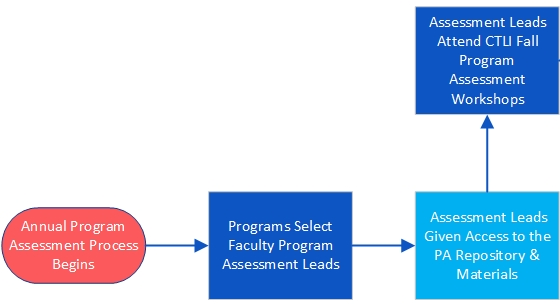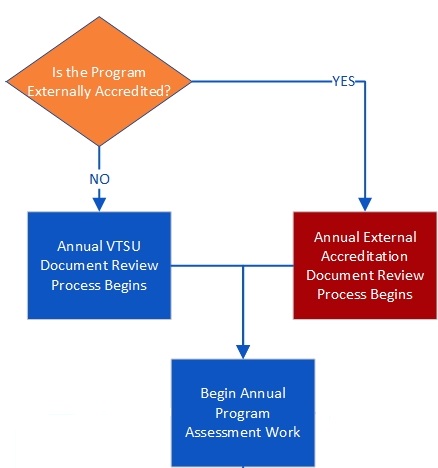Related Pages
- Program Assessment Overview
- Program Assessment Glossary
- Program Assessment Literature
- Detailed Program Assessment Guide
- Step 1: Articulate Program Mission & Goals
- Step 2: Identify Specific Program Outcomes
- Step 3: Crosswalk the Curriculum & Identify Signature Assignments
- Step 4: Identify & Gather Evidence & Interpret Results
- Step 5: Recommend Actions
- VTSU Program Assessment Sharepoint Repository
On this page
ToggleThe steps below include the specific actions that are taken during the program assessment process at Vermont State University, which satisfies the requirements set forth in VSC Policy 101, and aligns with the flowchart that depicts the process at a high level.
Please note that the flow of information will be the same for all programs, but the files used and the timing of their submission will vary for programs that are externally accredited.
As shown in Figure 1, the program assessment process is initiated at the beginning of the Fall semester. At this time, a faculty member(s) is chosen to act as the program assessment lead who develops the documents required for that program’s year in the assessment cycle.
Once the assessment lead is selected, access to the Program Assessment SharePoint site is provided and the lead can download the necessary document templates and examples of work submitted by other assessment leads during prior years.
In addition to the templates and examples, the assessment lead should review the assessment lead’s responsibilities as well as the Road Map in Step 3 of this Guide. Also, leads should download a copy of the Program Assessment Data Summary Workbook from Step 3 of this Guide, which is a useful template for developing rubrics and organizing data throughout the 5-year program assessment cycle.
Faculty Leads are encouraged to consult with the CTLI, Institutional Research, and their Dean if they have questions about program assessment or how to lead efforts for the year.

The assessment lead next needs to verify whether their program is externally accredited or internally reviewed.
It is important to note that externally accredited programs complete the documentation required by their accrediting bodies NOT the VTSU forms posted in the Program Assessment SharePoint site. The document submission and internal review process, however, is the same regardless of accreditation type.
Once accreditation status has been verified, the assessment lead begins their annual program assessment work as depicted in Figure 2.

Programs will need to develop an assessment system that works for them, recognizing that “the end of assessment is action” (Walvoord, 2010, p. 59).
To assist programs in developing an assessment system, two resources are available: a Road Map and a Program Assessment Workbook [Excel File].
The university is an advocate of making the assessment process as collaborative and supportive as possible. Programs are encouraged to involve all their faculty (including those that teach in VTSU Online programs), engage in assessment work throughout the academic year, and foster a culture of curiosity and continuous improvement.
Additionally, utilizing university resources to support program assessment is recommended. The SharePoint site includes the contact information for the CTLI, Institutional Research, and other support services as shown in Figure 3.
Assessment leads are encouraged to reach out for assistance if any steps in the process are confusing or unclear. The resulting consultations can clarify best practices in program assessment as well as the purpose of the forms and recommendations for completion.
Assessment leads are responsible for submitting required documents using the VTSU Faculty Program Assessment Submission form, attending to due dates in both January and June (depending on the program’s assessment cycle year).
If the documents are incomplete or require changes, the program coordinator will contact the assessment lead to request changes.
Walvoord, B. E. (2010). Assessment clear and simple: A practical guide for institutions, departments, and general education (2nd ed.). Jossey-Bass.

Considering the importance of continuous program improvement and accreditor oversight, a second review of the submitted documentation is completed by the appropriate academic dean following the initial review conducted by the program coordinator. If any concerns are identified, the dean will contact the program coordinator and assessment lead with a request to modify the submitted file(s).
If all documentation is in order, the files are saved to the program assessment repository and the program’s assessment process for that academic year is finished.
